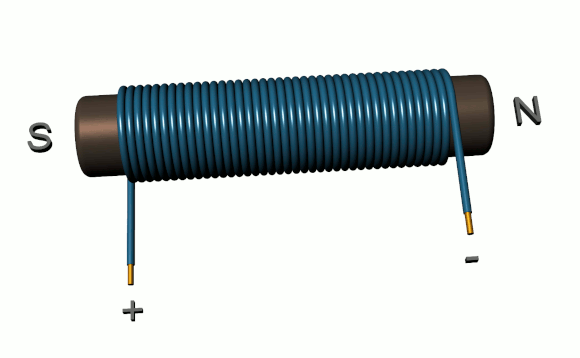
An electromagnet is a type of magnet in which the magnetic field is produced by the flow of an electric current. If the flow of electric current disappears, the magnetic field and the emanating effect of it also disappear.

These electrical devices are used to generate controllable magnetic forces in industrial applications such as electromagnetic cranes and sorting systems. They also play a crucial role in medical technology, enabling the creation of detailed images in magnetic resonance imaging (MRI) and magnetic stimulation therapies.
In everyday life, different types of electromagnets are used in a wide variety of examples. Their ability to change and control magnetic fields has driven innovation in a wide range of fields, from transportation to medicine and advanced research.
Types of electromagnets
There are different types of electromagnets depending on the direction of the current and the desired power. Among them, the most notable are circular current, direct current, rectangular and drive types.
Circular current electromagnets
These electromagnets have a wire wound into a spiral or circle. Electric current flows along this circular spiral, generating a magnetic field in a direction perpendicular to the plane of the circle.
They are used in applications where a magnetic field is needed in a specific area and in a particular direction.
Small electric motors, such as those in a fan, are two examples where circular current electromagnets can be used to generate motion.
Direct current electromagnets
These electromagnets operate on a constant, unidirectional electric current. The current flows in only one direction through the coiled wire, creating a constant magnetic field.
They are common in applications where a constant magnetic force is required, such as in electromagnetic relays.
This type of electromagnet is used in electric doorbells. In this example, the current flows in only one direction to operate a bell mechanism.
Rectangular electromagnets
Rectangular electromagnets have a rectangular design. Electric current flows through wire wound around the perimeter of the rectangle.
These electromagnets are used in situations where a magnetic field is sought in a specific direction or when a rectangular shape is more suitable for the application.
Rectangular electromagnets are used in devices such as speakers, where the rectangular design helps control the shape of the magnetic field needed to move the cone and produce sound.
Electromagnets for driving
Actuating electromagnets are used to exert a controlled force or motion in response to changes in electrical current. They are common in actuating devices, such as solenoids, that open and close valves, activate switches, or produce precise motions in automated systems.
A common example of actuating electromagnet is automatic door opening mechanisms, which use solenoids to control access.
Examples of electromagnets
These elements can be used directly or indirectly. In both cases we can find the following examples:
- To deflect electrically charged particles, as in cathode ray tubes, or particle accelerators.
- For lifting large masses of iron. Some cranes use powerful industrial electromagnets to hook and lift iron scrap.
- Electric motors. Electric motors operate using this technology.
- Electric generators. They work in the same way as electric motors but in reverse.
- Closing electrical contacts in relays or operating valves in solenoid valves.
- Activate electric locks
- Moving the head of a hard drive
- Electromagnetic brakes and clutches in automobiles.
- For magnetically separating metals in recycling centers.
- Magnetic levitation trains use this technology to float and greatly reduce friction losses with the track.
Example of use in automatic doors
Another example of use is in the field of locks, where it is used to keep a door closed, ensuring its opening in the event of a power outage.
Around 1980, the magnetic field derived from an electromagnet began to be used in construction and, more specifically, in the field of security windows.
A Swiss company began producing an electromagnet, very small in size and weight, which, when powered at low voltage (12Vdc - 24 Vdc), developed a magnetic field capable of withstanding a force of several thousand newtons.
This application was immediately a great success in the field of emergency exits because it guaranteed security against theft without the need to use mechanical parts but, at the same time, ensured the opening of the door, without human intervention, in the event of a power failure.
The evolution of this system has led the construction sector to massively use the electromagnet as an electrical closing element. Today it is used in various ways depending on the dimensions, uses, profiles and type of door.
Electromagnets in electric motors
In electric motors, they are the main components responsible for generating motion from electrical energy. In electric motors, electromagnets are used to create magnetic fields that interact with electric currents and generate forces that drive motion.
Electric motors can be classified into several types, with direct current (DC) motors and alternating current (AC) motors being the most common. In both cases, electromagnets play a crucial role:
Direct current (DC) motors
In these motors, the flow of electric current is constantly reversed to maintain the continuous rotation of the rotor (moving part of the motor). Electromagnets, called coils, are arranged in the stator (stationary part of the motor) and generate magnetic fields that interact with the rotor coils.
The switching of electric current in the stator coils creates a rotating magnetic field that spins the rotor.
Alternating Current (AC) Motors
Alternating current motors can be either induction or synchronous. In induction motors, the magnetic field is created in the stator by electromagnets supplied with alternating current. This magnetic field induces currents in the rotor, which generates movement.
In synchronous motors, the rotor rotates at the same speed as the rotating magnetic field of the stator, which requires precise timing.
A bit of physics: How does an electromagnet work?
An electromagnet works thanks to the property experienced by all electrical conductors: when a current flows through a conductor, a magnetic field is always generated.
The simplest type of electromagnet is a piece of metal wire wound into a coil. A cylindrical coil with the wire wound into a helix (similar to a corkscrew) is often called a solenoid; a closed solenoid would be a toroid . The ends of the wire are connected to a power source.
 Stronger magnetic fields can be produced by placing a core of a paramagnetic or ferromagnetic material inside the coil, usually a soft iron core. The core concentrates the magnetic field so that it will be stronger than if the coil winding alone were present.
Stronger magnetic fields can be produced by placing a core of a paramagnetic or ferromagnetic material inside the coil, usually a soft iron core. The core concentrates the magnetic field so that it will be stronger than if the coil winding alone were present.
The type of current with which an electromagnet works can be direct or alternating.
The magnetic fields generated by the coils follow a form of right-hand rule. If the fingers of the left hand are curved in the direction of the electron current flow through the coil, the thumb points in the direction of the magnetic force.
The side of the magnet from which the field lines emerge is considered the North Pole.
Differences between a magnet and an electromagnet
The most important differences between a permanent magnet and an electromagnet are the following:
-
The magnetic field of an electromagnet can be manipulated rapidly by controlling the amount of electric current. However, a continuous supply of electrical energy is required to maintain the field.
-
The magnetic force of the electromagnet depends on the power supply. If the current stops flowing, the electromagnet loses its properties.
Inventor of the electromagnet
The inventor of the electromagnet was the English physicist William Sturgeon , in 1825.
The first electromagnet was a horseshoe-shaped piece of iron surrounded by a coil. In this horseshoe, when the current passed through the coil of the electromagnet, it became magnetized and when it stopped, it became demagnetized.
Sturgeon demonstrated the magnetic properties of the electromagnet by lifting a piece of iron weighing less than 200 grams, about 4 kg, with a coil through which the current of a single-cell battery passed.
In addition, Sturgeon could regulate his electromagnet by varying the intensity of the electric current.